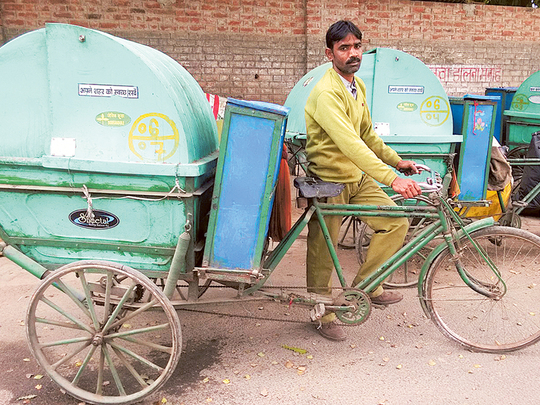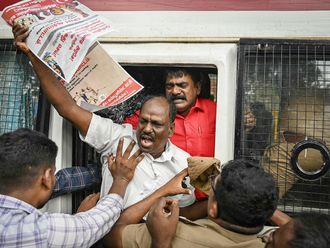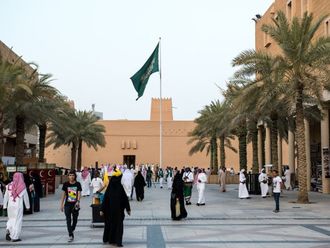
His work may be considered small, but his achievement is a major game changer. Thirty-five-year-old Khokhan Hamid has been awarded the United Nations Climate Solutions Award for keeping the environment clean. Hamid, who makes a living out of picking e-waste, was chosen for his initiative in training waste pickers to safely collect and dispose of electronic waste.
Along with him, Delhi-based NGO Chintan Environmental Research and Action Group bagged the 2015 United Nations Momentum for Change Award in the Urban Poor Category. Hamid has been associated with Chintan for the last more than one decade. Not just any waste picker, Hamid is the face of millions of his ilk, who pick up garbage from households and dumps.
It goes to the credit of Chintan that it recognised the need for e-waste collection and safe disposal as early as in 2002 and began working with a collective of waste recyclers that comprised waste pickers, doorstep waste collectors, small buyers and junk dealers. The collective was registered in 2009.
Hamid provides an insight into his life and work to Gulf News.
GULF NEWS: Is winning the UN Award a tribute to rag pickers, who while working to earn a living end up cleaning the city and its environment?
KHOKHAN HAMID: It certainly is. Elated at the honour bestowed upon me for not only being chosen for this award, but also receiving it at such a prestigious platform such as COP21 in Paris, is something I could never have dreamt of. But along with this recognition I very much hope that my living condition improves and I am able to provide a better life to my family. A decade ago, when I began collecting garbage, it was only a means of livelihood. But as times changed and my work of e-waste collection multiplied, I expected to offer my children, a daughter and a son, studying in Grade 10 and 7 respectively, more than just two square meals a day. But despite the award, the ground reality is that life remains a struggle, where my wife has to work as a housemaid and I continue to earn even less than her!
With the government’s Clean India agenda, haven’t things changed for you?
I am one of the 12,000 persons trained by NGO Chintan, which in cooperation with Delhi’s Pollution Control Committee and the city’s Department of Environment created a partnership with Safai Sena, a registered association of waste pickers. The sad part is that even while garbage collectors working in government departments earn huge salaries, people like us, who play a key role in mitigating e-waste related carbon emissions in the city, do not get even a fraction of that amount.
Since when have you been working?
Originally from Ghudiyari Sharif in Kolkata, West Bengal, my parents and I came to Delhi in 1988 and began living in Nizamuddin Basti. I have been working as a ragpicker since the age of 14 and ever since I came in touch with Chintan, I have been collecting waste from 90-odd houses at Pandara Road, a VIP area in central Delhi.
What works are you involved in?
Chintan has trained us to collect unusable electronic waste such as computer parts, printers, photocopy machines, typewriters, fax machines, telephones, mobile phones, refrigerators and air conditioners for safe disposal and recycling. By recycling raw materials from discarded items, natural resources are conserved and air and water pollution caused by hazardous disposal is avoided. We have been apprised of the fact that recycling e-waste from landfills reduces methane emissions, which are 25 times more potent than carbon dioxide at trapping heat in the atmosphere.
What aspects of your work would you want people to understand?
It’s a lowly work, but its impact is huge. So, I expect and request people to understand the importance of the work we do. Burning e-waste is hazardous not just for all of us, but also the environment. The toxic metals and flame retardants result in severe environmental problems and cause various diseases. Recycling instead of producing new materials will also reduce overall energy consumption, avoiding direct greenhouse gas emissions.
Exposed to higher levels of pollution and dangerous toxins, isn’t it hazardous for waste pickers?
It is. But then someone has to do it and we do so to earn a living. People like me help clean up the country’s cities by recycling approximately 20 per cent of the waste generated. Despite that we do not have equal rights, secure and safe livelihoods and dignity. With an increase in urbanisation, the amount of waste is only going to increase. We request the concerned authorities to formalise this sector so that we handle our work in more humane conditions.
India e-waste
• A UN report indicates India is the world’s fifth largest producer of e-waste, discarding almost 1.7 million tonnes of e-waste in 2014. Almost 95 per cent of the e-waste it produces is either burnt or dumped in landfills.
• For some time now, e-waste is instead collected directly from households, schools, businesses and other institutions and recycled safely.
• As Chintan’s model of handling e-waste is highly replicable due to its low cost, other cities and countries too can adopt it.
• Many countries such as Nepal, Bangladesh, Thailand and Ghana also produce a considerable amount of e-waste, which is handled by waste pickers. It is, therefore, very necessary to generate awareness on better e-waste practices, which has a huge potential in providing sustainable livelihood to the waste pickers.












